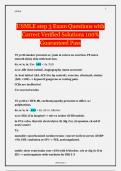1
USMLE
USMLE step 3 Exam Questions with
Correct Verified Solutions 100%
Guaranteed Pass
75 yo M smoker presents w/ pain in calves on exertion. PE notes
smooth shiny skin with hair loss.
dx, w/u, tx, f/u - ANS ✓dx: PAD
w/u: ABI (best initial), Angiography (most accurate)
tx: best initial: ASA, ACE (for bp control), exercise, cilostazol, statins
(LDL <100)--> bypass if gangrene or resting pain.
CCBs are ineffective!
f/u: several weeks.
75 yo M w/ HTN, MI, cardiomyopathy presents to office, w/
palpitations.
dx, w/u, tx - ANS ✓dx: AF vs. Aflutter
w/u: EKG, if in hospital--> tele vs. holter (if HD stable).
in CCA: echo, thyroid, electrolytes (K, Mg, Ca), (troponins, ck-mb if
acute onset)
Tx:
unstable: syncrhonized cardioversion- convert in first screen (if SBP
<90, CHF, confusion or CP)--> TEE, anticoagulated.
stable: slow ventricular rate <100 with b-blocker, ccb or dig (iv if in
ED)--> anticoagulate with warfarin for INR 2-3
USMLE step 3
, 2
USMLE
ABI:
1. what's normal
2. what's PAD - ANS ✓1. >= 0.9
2. > 10% = obstruction
when to use bb as tx? - ANS ✓ischemic heart disease
migraines
graves
pheo
when to use CCB - ANS ✓asthma
migraines
when to use dig? - ANS ✓borderline hypotension
75 yo M w/ HTN, MI, COPD presents to office, w/ palpitations,
tachycardia. EKG shows polymorphic P waves
dx, tx, f/u, what to never use!! - ANS ✓dx: MAT
w/u: EKG, holter or tele if high suspicion, in CCS, Echo
tx: ?
NEVER USE BETA BLOCKERS OR DIG!!
75 yo M w/ HTN presents to office, w/ palpitations, tachycardia. EKG
shows regular rhythm, but rate of 160-180
dx, w/u, tx, f/u - ANS ✓dx: SVT
USMLE step 3
, 3
USMLE
w/u:EKG--> holter or tele if high suspicion, in CCS, Echo
tx
f/u
why should one discontinue Raloxifene prior to surgery? - ANS ✓it
increases risk for DVT and PE
What should you think about in any young patient with vague
symptoms and significant unintentional weight loss? - ANS ✓HIV
what is the most common cause of secondary hypertension in young
patients - ANS ✓renal parenchymal disease
what is the most common cause of HTN in:
infants:
early childhood
adolescent - ANS ✓infants: renal artery/ vein thrombosis 2/2 umbilical
artery catheters
early childhood: renal parenchymal disease, coarctation, endocrine,
medications
Adolescent: essential HTN (Obesity), evaluate for renal and
renovascular HTN.
what are the clinical risk factors for DVT (10) - ANS ✓age >40
prolonged immobility or paralysis
prior DVT/PE
USMLE step 3
, 4
USMLE
obesity
hypercoagulable states
major surgery/ fx
malignancy
varicose veins
heart failure
MI
what are the modalities of DVT ppx from most effective --> least
effective - ANS ✓1. full dose therapeutic IV heparin- (reserved for MI pts)
2. either oral warfarin (INR 2.5) or LMWH-- high risk surgeries
3 ICD or calf-length elastic stockings with early ambulation
when is surgical removal of pelvic cysts during pregnancy indicated? -
ANS ✓adnexal cysts >5 cm that persists over time--> high risk of rupture,
hemorrhage, torsion--> preterm delivery
who should receive ppx for mening? - ANS ✓people living in same
household who have prolonged, close contact and
healthcare workers w/ direct exposure secretions.
what is nelson's syndrome? - ANS ✓pituitary enlargement and
hyperpigmentation following b/l adrenalectomy
what is the underlying etiology of muscle weakness in a critically ill
patient after many days of glucose infusion? - ANS ✓hypophosphatemia
USMLE step 3




